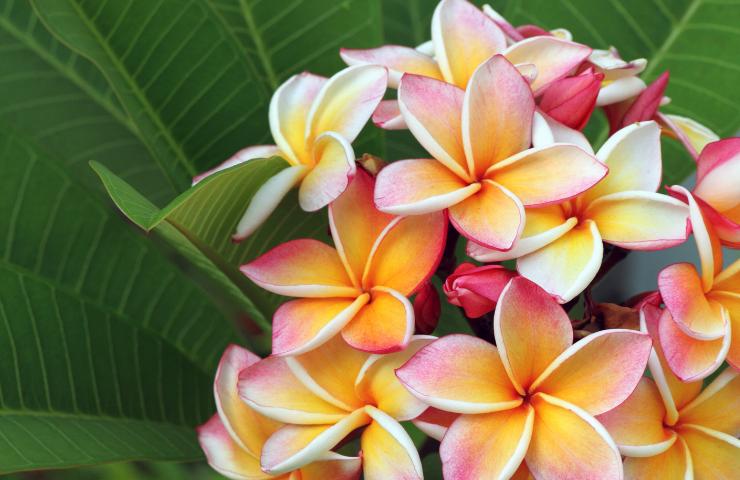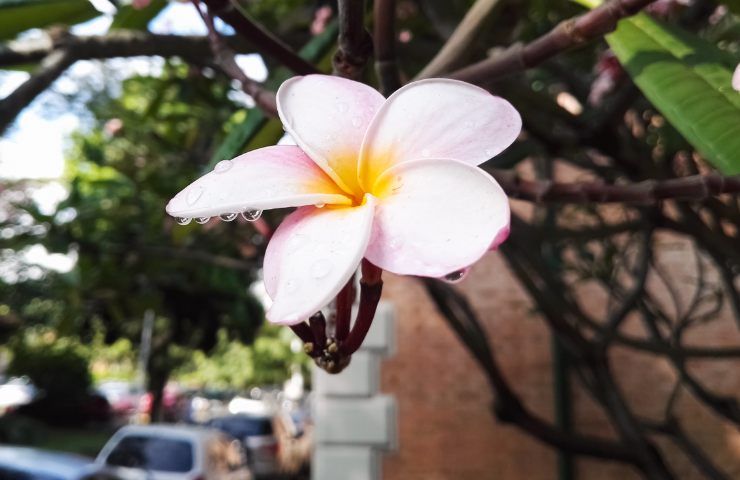
A tropical plant with fragrant flowers and decorative foliage, Plumaria is always highly appreciated both for ornamental use in warm climates and as a potted plant where the climate is not favorable. Its beauty and scent make it a very popular choice for gardens and outdoor spaces.
Main characteristics of Plumaria
If the name doesn’t mean much to you, know that Plumaria is also known as Frangipani or Pomelia. This wonderful plant belongs to the genus of tropical plants of the Apocinacee family. It appears as a medium-sized tree and shrub, the typical sculptural shape is given by the fleshy branches that become woody over time , but its great aesthetic value is certainly given by its large leaves and exotic flowers. Plumaria is, therefore, the scientific name of the best-known Frangipane. Its scent is so intoxicating that it is also often used in pastry making. It belongs to the Plumbago genus, with their typical semi-evergreen foliage. This plant comes from Central and tropical America, i.e. from the warm regions of Mexico, the Caribbean and Brazil.
Curiosities about Plumaria

This potted shrub is small in size and has large, showy leaves that are very decorative, and for this reason it is one of the most loved ornamental plants in the world. In Italy it can be successfully grown outdoors only in the warmest areas such as Sicily and the southern regions. Its beautiful flowers can have different colorswhich vary from white to pink, but it is not uncommon to also find it in yellow and coral red. The flowers give off the strong and typical scent of frangipani, particularly during the night hours. In addition to the typical leaves and fragrant flowers, Plumaria is known for its quickly growing straight and fleshy branches rich in white latex. Over time, however, these branches become woody, so much so that they make the plumaria very beautiful even in the absence of leaves and flowers. The wood, when the plant reaches large dimensions, is used in carpentry and as firewood ; in fact, the height can reach large dimensions and reach a height of 10 metres.
Useful information on Plumaria

Position
We have already said that to thrive this plant requires high temperatures, and a typically warm and temperate climate of the warmer regions as its roots cannot resist the cold below 5 degrees. It loves the sun and does not tolerate the cold wind typical of the winter season, which is why cultivation in pots is recommended so that it can be moved to shelter in the winter months.
Ground
Plumaria requires a specific type of soil, sandy and with an alkaline soil acidity.
Watering
Plumaria generally doesn’t need a lot of water , but it all depends on what stage of growth it is in and the season. Its large leaves require constant irrigation in the heat, but it is essential that water stagnation is not created , so as to avoid both root and apical rot. In winter, however, with the loss of leaves, watering must be gradually reduced, while in the harsher winter months monthly watering is recommended, but it is important that the trunk remains turgid. In the spring period and with the rise in temperatures it is possible to resume regular irrigation. However, remember to wait until the soil is dry between one watering and another.
Pruning
Plumaria needs precise times to be pruned and its maintenance is very strict. Dead and diseased branches can be eliminated all year round, but coppicing and pollarding can be done from February to April. If necessary, the roots of well-established specimens can be pruned in March. While when in flower, pruning can be done in the month of June. However, when the Plumaria loses its leaves and flowers, it can only be pruned in the months of August and September. From September to December it is possible to continue pruning it for maintenance or renewal of stripping hedges. The important thing is to always give a specific shape , and choose the right cut to stimulate the plant to create new branches if you don’t want it to grow too tall.
Fertilization
When the Plumaria is in the vegetative growth phase it is possible to start fertilizing it, so as to help it produce first the leaves and then the flowers. As with pruning, fertilization also follows a specific calendar ; if the plant is in a pot, ideal fertilization must take place in the months of February and March. If the plant is planted in loose ground, then September and October will be the ideal months.
Multiplication
Plumaria lends itself well to propagation by cuttings , but success depends on whether or not rooting powder is used. Softwood cuttings and planting can take place in the months leading up to summer, March and April are ideal. For grafting and budding, keep in mind that the favorable period is from July to mid-August. For semi-mature cuttings, however, the ideal period is from mid-August to mid-September, while for semi-mature and mature cuttings we move to the months of January and February and from mid-December to the end of December.
Diseases and Parasites
In addition to the ideal temperature and irrigation, it is crucial to choose a well-ventilated place so as to best protect the plant from the possible attack of mites, particularly on the shoots, the most fragile part of the plant. If the plant becomes infested it is necessary to act promptly and use specific products.
Beneficial Properties of Plumaria
In the medicinal field this wonderful plant is used to treat disorders of the intestinal and digestive system, but also for skin diseases and much more. Be careful though, the plumaria as it is is highly toxic , in all its parts starting from the fleshy branches, moving from the leaves to the flowers.